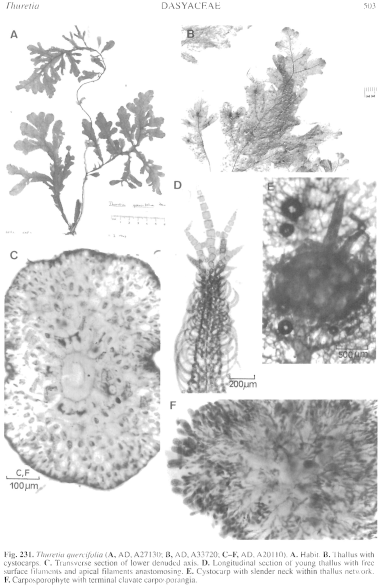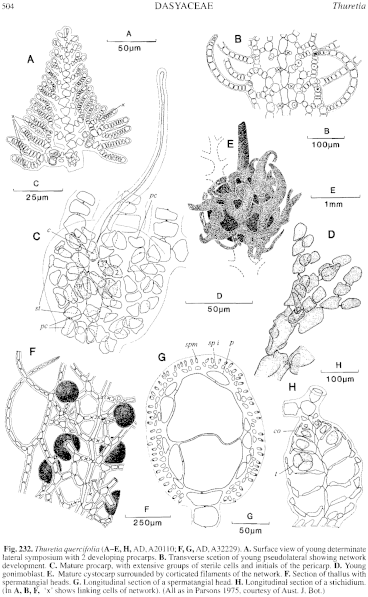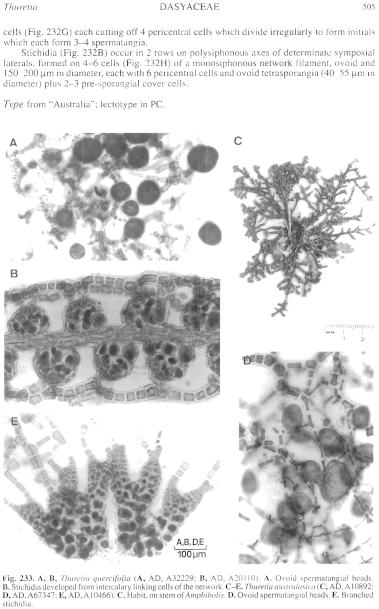|
|
|
|
|
|||||||||||
|
Electronic Flora of South Australia Species Fact Sheet
Phylum Rhodophyta – Order Ceramiales – Family Dasyaceae
Selected citations: De Toni 1903: 1175; 1924: 436. De Toni & Forti 1923: 50. Falkenberg 1901: 668, pl. 17 figs 1–9. Fuhrer et al. 1981: pls 73, 74. Harvey 1855a: 537; 1858: pl. 40; 1863, synop.: xiv. Kützing 1849: 673; 1862: 20, pl. 64e-g. Lucas 1912: 157; 1929b: 52. Lucas & Perrin 1947: 308, fig. 147. May 1965: 394. Mazza 1910: No. 342. Parsons 1975: 635, figs 23–25, 45A. Reinbold 1899: 48. Schmitz & Falkenberg 1897: 475, fig. 264a-c. Silva et al. 1996: 444. Sonder 1853: 696. Womersley 1950: 182.
Synonym
Dictyurus quercifolius (Decaisne) J. Agardh 1863: 1245. De Toni 1896: 228. Sonder 1881: 31.
Thallus (Fig. 231A, B) medium to dark red, erect to decumbent, 10–25 cm high, complanately and laterally branched with flat branches mostly 1–2.5 cm broad and 0.5–1 mm thick, with polysiphonous axes bearing a network of monosiphonous filaments with surface unbranched filaments becoming spine-like on the margins (Fig. 231D), denuded below with slender axes. Holdfast conical, rhizoidal, 1–3 mm across, spreading by stolons. Structure. Apices sympodial (Fig. 232A), forming alternately distichous pseudolaterals which develop into determinate sympodial laterals forming the flat branches. Pericentral cells 4, formed in alternating sequence. Pseudolaterals occur alternately on each cell of the determinate laterals (Fig. 232A), and the monosiphonous network develops by branchlets becoming linked by small lateral cells (Fig. 232B), with free curved filaments (Figs 231D, 232F) on the surface of the network, more spine like on the thallus margin. Inner cells 25–55 µm in diameter and L/D 0.6–2, cells of free surface filaments 15–40 in diameter and L/D 1–3, when spine like, cells 50–150 µm in diameter and L/D 0.5–1. Mature axes become corticated by filaments arising from the pericentral cells which are no longer recognisable in older axes (Fig. 231C). Lateral axes arise from pseudolaterals near the apices. Rhodoplasts discoid in smaller cells, becoming chained or ribbon like in larger cells.
Reproduction: Gametophytes dioecious. Procarps occur (Fig. 232C) on basal branches on determinate sympodia, with 5 pericentral cells, the fourth of which forms a sterile group and a carpogonial branch; the supporting cell forms a second sterile group. Post-fertilization a fusion cell develops from the auxiliary cell and central cell of the fertile segment and involves also the other pericentral cells and lower gonimoblast cells (Fig. 232D); the sterile groups divide extensively. The gonimoblast (Fig. 231F) is much branched with terminal clavate carposporangia 25–35 µm in diameter. Cystocarps (Figs 231B, E, 232E) lie within the filamentous network, ovoid, on a short corticate stalk, 1–2 mm in diameter, corticated, with a prominent neck 0.7–1.2 mm long protruding through the network; the pericarp arises pre-fertilisation by division of the sterile pericentral cells, with the erect filaments becoming 5–6 layered with small outer cortical cells. Spermatangial branches (Figs 232F, 233A) are terminal on short filaments within the network, subglobose and 70–150 µm in diameter, with 3–4 axial cells (Fig. 232G) each cutting off 4 pericentral cells which divide irregularly to form initials which each form 3–4 spermatangia.
Stichidia (Fig. 232B) occur in 2 rows on polysiphonous axes of determinate symposial laterals, formed on 4–6 cells (Fig. 2321–1) of a monosiphonous network filament, ovoid and 150–200 µm in diameter, each with 6 pericentral cells and ovoid tetrasporangia (40–55 µm in diameter) plus 2–3 pre-sporangial cover cells.
Type from "Australia"; lectotype in PC.
Selected specimens: Dongara, W. Aust., drift (Smith, 6.iv.1968; UWA, A895). Tims Thicket, S of Mandurah, W. Aust., drift (Allender, 7.v.1967, UWA, A896). Eyre, W. Australia, drift (Parsons, 22.xi.1968; AD, A34398). Head of the Great Australian Bight, S. Aust., drift (Parsons, 4.xi.1968; AD, A35123). Elliston Bay, S. Aust., 10–12 m deep (Shepherd, 24.x.1969; AD, A34964). West Point, Eyre Pen., 15–25 m deep (Shepherd, 25.x.1969; AD, A34772). Tiparra reef, S. Aust., on Amphibolis griffithii, 12 m deep (Shepherd, 27.vii.1970; AD, A36008). Dany Beach, Yorke Pen., S. Aust., drift (Womersley, 15.x.1989; AD, A59890). Tapley Shoal, Gulf St Vincent, 13 m deep (Shepherd, 5.ii.1969; AD, A33770x "Marine Algae of southern Australia" No. 117). Stanley Beach, Kangaroo 1., S. Aust., drift (Womersley, 7.ii.1956; AD, A20110). Stinky Bay, Nora Creina, S. Aust., drift (Parsons, 9.ii.1968; AD, A32229). Port Phillip Heads, Vic. (Wilson, 15.i.1895; MEL, 1006581). Walkerville, Vic., drift (Sinkora A2094, 27.0.1975; AD, A48396). King I., Bass Strait (Spong, 1882; MEL, 1006571). Bridport, Tas., drift (Parsons & Womersley, 6.xi.1982; AD, A54532).
Distribution: Dongarra, W. Aust., to Walkerville, Vic., and N Tasmania.
Taxonomic notes: Thuretia quercifolia is a common and distinctive species on southern rough-water coasts, usually occurring in deeper water.
References:
AGARDH, J.G. (1863). Species Genera et Ordines Algarum. Vol. 2, Part 3, pp. 787–1291. (Gleerup: Lund.)
DE TONI, G.B. & FORTI, A. (1923). Alghe di Australia, Tasmania e Nouva Zelanda. Mein. R. Inst. Veneto Sci., Lett. Arti 29, 1–183, Plates 1–10.
DE TONI, G.B. (1896). Pugillo di alghe Australiane Raccolte all'isola di Flinders. Boll. Soc. Bot. Ital. 1896, 224–231.
DE TONI, G.B. (1903). Sylloge Algarum omnium hucusque Cognitarum. Vol. 4. Florideae. Sect. 3, pp. 775–1521 + 1523–1525. (Padua.)
DE TONI, G.B. (1924). Sylloge Algarum omnium hucusque Cognitarum. Vol. 6. Florideae. (Padua.)
DECAISNE, J. (1844). Note sur quelques algues à frondes réticulées. Ann. Sci. Nat., 3 Sér. Bot. 2, 233–236.
DECAISNE, J. (1846). Atlas Botanique. In A. Du Petit-Thouars (Ed.). Voyage autour du monde sur la fregate la Vénus pendent les anées 1836–1839. 34+11pp. (Paris.)
FALKENBERG, P. (1901). Die Rhodomelaceen des Golfes von Neapel und der angrenzenden Meeres-abschnitte. Fauna und Flora des Golfes von Neapel. Monogr. 26. (Friedlander: Berlin.)
FUHRER, B., CHRISTIANSON, I.G., CLAYTON, M.N. & ALLENDER, B.M. (1981). Seaweeds of Australia. (Reed: Frenchs Forest, Sydney.)
HARVEY, W.H. (1855a). Some account of the marine botany of the colony of Western Australia. Trans. R. Jr. Acad. 22, 525–566.
HARVEY, W.H. (1858). Phycologia Australica. Vol. 1, Plates 1–60. (Reeve: London.)
HARVEY, W.H. (1863). Phycologia Australica. Vol. 5, Plates 241–300, synop., pp. i-lxxiii. (Reeve: London.)
KÜTZING, F.T. (1849). Species Algarum. (Leipzig.)
KÜTZING, F.T. (1862). Tabulae Phycologicae. Vol 12. (Nordhausen.)
LUCAS, A.H.S. & PERRIN, F. (1947). The Seaweeds of South Australia. Part 2. The Red Seaweeds. (Govt Printer: Adelaide.)
LUCAS, A.H.S. (1912). Supplementary list of the marine algae of Australia. Proc. Linn. Soc. N.S.W. 37, 157–171.
LUCAS, A.H.S. (1929b). A census of the marine algae of South Australia. Trans. R. Soc. S. Aust. 53, 45–53.
MAY, V. (1965). A census and key to the species of Rhodophyceae (red algae) recorded from Australia. Contr. N.S.W. natn. Herb. 3, 349–429.
MAZZA, A. (1910). Saggio di Algologia Oceanica. Nuova Notarisia 21, Nos. 309–368.
PARSONS, M.J. (1975). Morphology and taxonomy of the Dasyaceae and Lophothalieae (Rhodomelaceae) of the Rhodophyta. Aust. J. Bot. 23(4), 549–713.
REINBOLD, T. (1899). Meeresalgen von Investigator Street (Slid Australien), gesammelt von Miss Nellie Davey (Waltham, Honiton). Hedwigia 38, 39–51.
SCHMITZ, F. & FALKENBERG, P. (1897). Rhodomelaceae. In Engler, A. & Prantl, K., Die nattirlichen Pflanzenfamilien. T.1. Abt. 2, pp. 421–480. (Englemann: Leipzig.)
SILVA, P.C., BASSON, P.W. & MOE, R.L. (1996). Catalogue of the Benthic Marine Algae of the Indian Ocean. (University of California Press: Berkeley, Los Angeles & London.)
SONDER, O.W. (1853). Plantae Muellerianae. Algae. Linnaea 25, 657–709.
SONDER, O.W. (1881). In Mueller, F., Fragmenta Phytographiae Australiae. Supplementum ad volumen undecinum: Algae Australianae hactenus cognitae, pp. 1–42, 105–107. (Melbourne.)
WOMERSLEY, H.B.S. (1950). The marine algae of Kangaroo Island. III. List of Species 1. Trans. R. Soc. S. Aust. 73, 137–197.
The Marine Benthic Flora of Southern Australia Part IIIC complete list of references.
Publication:
Womersley, H.B.S. (24 December, 1998)
The Marine Benthic Flora of Southern Australia
Rhodophyta. Part IIIC. Ceramiales – Ceramiaceae, Dasyaceae
©State Herbarium of South Australia, Government of South Australia
Illustrations in Womersley Part IIIA, 1998: FIGS 231, 232, 233A, B.

Figure 231 enlarge
Fig. 231. Thuretia quercifolia (A, AD, A27130; B, AD, A33720; C–F, AD, A20110). A. Habit. B. Thallus with cystocarps. C. Transverse section of lower denuded axis. D. Longitudinal section of young thallus with free surface filaments and apical filaments anastomosing. E. Cystocarp with slender neck within thallus network. F. Carposporophyte with terminal clavate carposporangia.

Figure 232 enlarge
Fig. 232. Thuretia quercifolia (A–E, H, AD, A20110; F, G, AD, A32229). A. Surface view of young determinate lateral symposium with 2 developing procarps. B. Transverse scetion of young pseudolateral showing network development. C. Mature procarp, with extensive groups of sterile cells and initials of the pericarp. D. Young gonimoblast. E. Mature cystocarp surrounded by corticated filaments of the network. F. Section of thallus with spermatangial heads. G. Longitudinal section of a spermatangial head. H. Longitudinal section of a stichidium. (In A, B,F, 'x' shows linking cells of network). (All as in Parsons 1975, courtesy of Aust. J. Bot.)

Figure 233 enlarge
Fig. 233. A, B, Thuretia quercifolia (A, AD, A32229; B, AD, A20110). A. Ovoid spermatangial heads. B. Stichidia developed from intercalary linking cells of the network. C–E. Thuretia australasica (C, AD, A 10892; D, AD, A67347; E, AD, A 10466). C. Habit, on stem of Amphibolis. D. Ovoid spermatangial heads. E. Branched stichidia.

|
Email Contact: State Herbarium of South Australia |

|